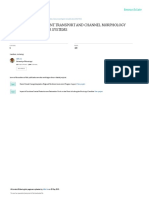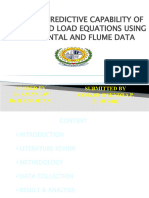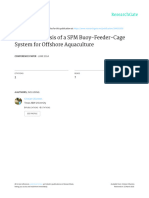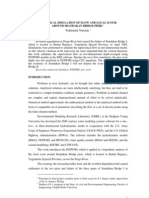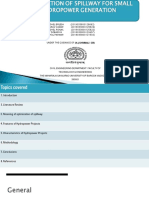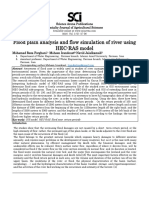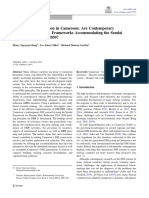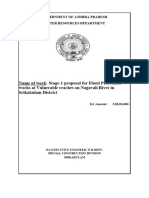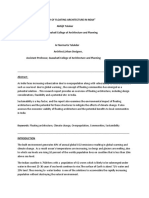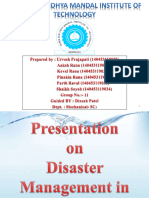0 ratings0% found this document useful (0 votes)
37 viewsYang Man Revised
Yang Man Revised
Uploaded by
dequanzhouThis document summarizes generalized sediment transport models developed by the US Bureau of Reclamation called GSTAR models. The models use a stream tube concept to simulate semi-two-dimensional flows and semi-three-dimensional bed variations. Minimum stream power theory is used to determine optimal channel geometry. Models include GSTARS, GSTARS 2.0/2.1, GSTARS3, and GSTAR-1D. They can model sediment transport, scour, deposition and river morphology. Examples show how the models have been used worldwide for engineering studies, research, and teaching.
Copyright:
© All Rights Reserved
Available Formats
Download as PDF, TXT or read online from Scribd
Yang Man Revised
Yang Man Revised
Uploaded by
dequanzhou0 ratings0% found this document useful (0 votes)
37 views10 pagesThis document summarizes generalized sediment transport models developed by the US Bureau of Reclamation called GSTAR models. The models use a stream tube concept to simulate semi-two-dimensional flows and semi-three-dimensional bed variations. Minimum stream power theory is used to determine optimal channel geometry. Models include GSTARS, GSTARS 2.0/2.1, GSTARS3, and GSTAR-1D. They can model sediment transport, scour, deposition and river morphology. Examples show how the models have been used worldwide for engineering studies, research, and teaching.
Original Description:
Sediment modeling
Copyright
© © All Rights Reserved
Available Formats
PDF, TXT or read online from Scribd
Share this document
Did you find this document useful?
Is this content inappropriate?
This document summarizes generalized sediment transport models developed by the US Bureau of Reclamation called GSTAR models. The models use a stream tube concept to simulate semi-two-dimensional flows and semi-three-dimensional bed variations. Minimum stream power theory is used to determine optimal channel geometry. Models include GSTARS, GSTARS 2.0/2.1, GSTARS3, and GSTAR-1D. They can model sediment transport, scour, deposition and river morphology. Examples show how the models have been used worldwide for engineering studies, research, and teaching.
Copyright:
© All Rights Reserved
Available Formats
Download as PDF, TXT or read online from Scribd
Download as pdf or txt
0 ratings0% found this document useful (0 votes)
37 views10 pagesYang Man Revised
Yang Man Revised
Uploaded by
dequanzhouThis document summarizes generalized sediment transport models developed by the US Bureau of Reclamation called GSTAR models. The models use a stream tube concept to simulate semi-two-dimensional flows and semi-three-dimensional bed variations. Minimum stream power theory is used to determine optimal channel geometry. Models include GSTARS, GSTARS 2.0/2.1, GSTARS3, and GSTAR-1D. They can model sediment transport, scour, deposition and river morphology. Examples show how the models have been used worldwide for engineering studies, research, and teaching.
Copyright:
© All Rights Reserved
Available Formats
Download as PDF, TXT or read online from Scribd
Download as pdf or txt
You are on page 1of 10
US-CHINA WORKSHOP ON ADVANCED COMPUTATIONAL MODELLING IN HYDROSCIENCE & ENGINEERING
September 19-21, Oxford, Mississippi, USA
GENERALIZED SEDIMENT TRANSPORT MODELS FOR ALLUVIAL RIVERS AND
RESERVOIRS
Chih Ted Yang
1
, Francisco J . M. Simes
2
, J ianchun Huang
3
, and Blair Greimann
4
ABSTRACT
The U.S. Bureau of Reclamation has developed a series of computer models (GSTAR) for the
simulation and prediction of sediment transport, scour, and deposition processes in alluvial rivers
and reservoirs. GSTARS, GSTARS 2.0/2.1 and GSTARS3 are based on the stream tube concept
using one-dimensional approach along stream tubes to obtain a semi-two-dimensional variation of
the hydraulic conditions in rivers and reservoirs. The hydraulic conditions coupled with uneven
distribution of scour and deposition among stream tubes can give a semi-three-dimensional variation
of the bed geometry. The theory of minimum stream power is used to determine the optimum
channel width and geometry. GSTARS, GSTARS 2.0/2.1 and GSTARS3 are intended for quasi-
steady flows. GSTAR-1D is a one-dimensional steady and unsteady flow and sediment transport
model. It can also model cohesive sediment transport, internal boundary conditions, and stream
networks. It does not include the same minimization methods of previous GSTARS models
The Generalized Sediment Transport models for Alluvial Rivers (GSTAR) have been used by
many organizations and universities around the world for engineering, research, and teaching
purposes. Examples of applications will be presented to illustrate the capabilities of using these
models for solving engineering problems.
1. INTRODUCTION
The U.S. Bureau of Reclamation (Reclamation) Technical Service Center has developed a series of
computer models for alluvial rivers and reservoirs. These models are in public domain and have
been applied by Reclamation, other government agencies, universities, research institutes, and
engineers in the United States and other countries for erosion, sedimentation, river morphology,
river engineering, and river restoration studies. These models have also been used by universities for
teaching purposes. One of the unique and common features of all the Generalized Sediment
Transport models for Alluvial Rivers (GSTAR) is the application of some optimization methods.
1
Borland Professor of Water Resources and Director, Hydroscience and Training Center, Colorado State University,
Fort Collins, CO 80523, USA. Phone: 1-970-491-8160 Fax: 1-970-491-8032 Email: ctyang@engr.colostate.edu
2
Research Hydrologist, U.S. Geological Survey, P.O. Box 25046 Mail Stop 413, Lakewood, CO 80225, USA. Phone:
1-303-236-4556 Fax: 1-303-236-5034 Email: frsimoes@usgs.gov
3
Hydraulic Engineer, U.S. Bureau of Reclamation Technical Service Center, Lakewood, CO 80225, USA. Phone: 1-
303-445-2158 Fax: 1-303-445-6351 Email: vhuang@do.usbr.gov
4
Hydraulic Engineer, U.S. Bureau of Reclamation Technical Service Center, Lakewood, CO 80225, USA. Phone: 1-
303-445-2563 Fax: 1-303-445-6351 Email: bgreiman@do.usbr.gov
2
The minimum stream power theory can be used for the determination of optimum channel
width and geometry for a given set of hydraulic, geological, sediment, and man-made constraints.
Another unique feature of GSTAR models is the application of stream tube concept using one-
dimensional computations alone stream tubes to simulate semi-two-dimensional flow conditions and
semi-three-dimensional variations of bed geometry. The stream tube computations are used for all
GSTAR models except GSTAR-1D (Yang et al. 2004).
This paper provides a brief description of GSTARS (Molinas and Yang 1989), GSTARS 2.0
(Yang et al. 1998), GSTARS 2.1 (Yang and Simes 2000), GSTARS3 (Yang and Simes 2002), and
GSTAR-1D (Yang et al. 2004) models. Some computed and predicted results from using these
models are used to illustrate the capabilities of using these models for alluvial river and reservoir
sedimentation and morphology studies.
2. THEORETICAL DEVELOPMENTS
2.1 Stream Tube Concept
A streamline is a conceptual line to which the velocity vector of the fluid is tangent at each and
every point, at each instant in time. Stream tubes are conceptual tubes whose walls are defined by
streamlines. The discharge of water is constant along a stream tube because no fluid can cross the
stream tube boundaries. For steady and incompressible fluids, the total head along a stream tube of
an ideal fluid is constant. For real fluids in alluvial rivers, water surface profile computation is used
to determine the energy loss in a study reach. Figure 1 provides a schematic representation of the
stream tube concept.
Figure 1. Schematic representation of the use of stream tube concept (Yang and Simes 2002).
2.2 Water Surface Profile Computation
For steady or quasi-steady flows, the standard-step method can be used for the water surface profile
computation based on the use of Manning, Chezy, or Darcy-Weisbachs formula. The local energy
loss due to contraction and expansion can also be computed. Detailed procedures of water surface
profile computation for single or divided channels are given by Molinas and Yang (1985). Water
3
surface profile computation in GSTAR models can be applied to sub-critical, super-critical, and a
combination of both without interruption.
2.3 Optimization Methods
The minimum energy dissipation rate theory was developed by Yang (1976, 1983a, 1983b, 1985)
and by Yang and Song (1979, 1986, 1990). The theory states that for a closed and dissipative system
in dynamic equilibrium, its energy dissipation rate must be at its minimum value. The minimum
value depends on the constraints applied to the system. An open system under equilibrium can be
converted to a closed system and the theory is still applicable (Yang and Song 1986). The minimum
energy dissipation rate theory can be derived not only from mathematical argument based on the
definition of a closed and dissipative system; it can also be derived from the basic law in
thermodynamics (Yang, 1971). For open channel hydraulics, the minimum energy dissipation rate
theory can be simplified to the minimum unit stream power theory if the velocity V and slope S are
fairly uniformly distributed at a given cross section, i.e.
VS =a minimum (1)
where VS =unit stream power or the rate of potential energy dissipation per unit weight of water
(Yang 1973). If the velocity is not uniformly distributed across a channel, it should be integrated
across the channel and the minimum stream power theory should be applied, i.e.
QS =a minimum (2)
where Q =water discharge, and QS =stream power.
It is apparent that the minimum unit stream power and minimum stream power theories are
special and simplified versions of the more general minimum energy dissipation rate theory. The
minimum values in Eqs. (1) and (2) depend on the constraints applied to the system. In addition to
geologic and man-made constraints, water discharge and sediment load are two common constraints
imposed on an alluvial river system. An alluvial river will adjust its channel geometry and slope to
minimize its stream power or unit stream power. Computed results from using Eq. (1) and Eq. (2)
may be different. Because Q is more readily available than V from field data, QS is more often used
by hydraulic engineers than VS in the minimization computations.
All GSTARS models except GSTAR-1D use Eq. (2) for the determination of optimum channel
geometry because the Q values are readily available from most river gauging station records.
GSTAR-1D provides four optimization options: maximization of channel conveyance; minimization
of total stream power which is the integration of QS along the study reach; minimization of energy
slope change; and minimization of bed slope change.
2.4 Channel Side Stability
With the exception of GSTAR-1D, all GSTARS models use Eq. (2) for the determination of
optimum channel geometry. The minimum QS value depends on local geological constraints, such
as the angle of repose of materials on the channel side slope or other geological conditions. Figure 2
illustrates how to balance the materials on the channel side slope based on the angle of repose. The
materials in abcb
a is balanced by the materials in cd
edc. Different values of angle of repose can be
assigned at different elevations to reflect the local geological conditions.
4
Figure 2. Schematic representation of channel side slope adjustment (Yang and Simes 2000).
2.5 Sediment Transport Formulas
More than a dozen of commonly used sediment transport formulas are included in the GSTAR
computer models for users to choose for the computation of non-cohesive and cohesive sediment
transport rates or concentrations. Yang (1996, 2003) made some recommendations on the selection
of sediment transport formulas under different flow and sediment conditions. Sediment transport
computations by size fractions, bed sorting and armoring are included in all GSTAR models. In
addition to equilibrium sediment transport, the method developed by Han (1980) is included in
GSTAR models for non-equilibrium sediment transport computations.
2.6 Numerical Solutions
The numerical method used in GSTAR models is a finite difference uncoupled method. Finite
difference method is used to discretize the governing differential equations. The uncoupled method
computes water surface profile first, and the sediment routing and bed changes are computed
afterwards, keeping all the hydraulic parameters frozen during the calculations. Users can choose
different weighting factors to best fit with local conditions.
GSTAR-1D is intended for truly unsteady flows and different numerical methods are needed.
GSTAR-1D uses a method similar to the New C scheme by Kntija and Newett (2002). The local
partial inertia technique (Fread and Lewis 1998) is used in GSTAR-1D to ensure stability for
supercritical flows.
The boundary conditions can be upstream or downstream using either a rating curve or a
known water surface elevation. Some internal boundary conditions such as dams, bridges, weirs, and
gates may exit along a natural river and special treatments are required in the numerical model. For
each internal cross sectional structure, the water discharge and water surface elevation values are
needed to satisfy the continuity equation and some special stage-discharge relationship of the
international boundary conditions. Structures currently supported by GSTAR-1D are listed in its
users manual (Yang et al. 2004). Internal boundary conditions are interpolated using a step function
for steady flow simulations and interpolated linearly in time for unsteady flow simulation. Internal
structures are assumed to occur between cross sections and are identified by the cross section that
occurs immediately upstream.
5
3. APPLICATIONS
3.1 GSTARS
The Generalized Stream Tube model for Alluvial River Simulation (GSTARS) was developed by
Molinas and Yang (1986) for main frame computer applications. Yang, et al. (1989) applied
GSTARS to simulate and predict the scour depth and pattern at the Lock and Dam No. 26
replacement site on the Mississippi River. Figure 3 shows the three-dimensional variations of
channel cross section at 4, 36, and 72 days of simulation using three stream tubes. The computed
scour depth from GSTARS is within 1 foot from field measurements. Reclamation no longer
maintains and uses GSTARS since the release of the PC version of GSTARS 2.0 in 1998.
4 days 36days 72days
Figure 3. Three-dimensional plot of the variation of computed scour pattern at the Mississippi River
Lock and Dam No. 26 replacement site (Yang, et al. 1989).
GSTARS was adopted and modified by Lee et al. (1989) to include the capability of flood
routing in a channel network with fluctuating downstream water surface elevation due to tide. The
modified GSTARS was successfully applied to the Keelung River flood control project and the
Shiemen Reservoir sedimentation studies in Taiwan. The simulated and predicted results are in good
agreement with field measurements and analytical solutions.
3.2 GSTARS 2.0/2.1
GSTARS 2.0 is the first PC version of the GSTAR model series. GSTARS 2.1 is a revised and
enhanced version of GSTARS 2.0. Some of the modifications and improvements made in GSTARS
2.1 over GSTARS 2.0 are : (1). Accepts tributary flows of sediment and water; (2) The codes were
rewritten from Fortran IV and Fortran 77 to Fortran 90/95 syntax; and (3). J ava-based graphical user
interface for data entry and analysis to make the model more user friendly. GSTARS 2.1 has
replaced GSTARS 2.0, and Reclamation no longer maintains GSTARS 2.0.
GSTARS 2.0 and GSTARS 2.1 have been used by engineers and researchers not only in the
United States but also in other countries. For example Cellino and Essyad (2002) applied GSTARS
2.0 to study engineering alternatives for reduction of sediment deposition in the Dranse River, which
is a tributary of the Rhone River in Switzerland. The computed results from GSTARS 2.0 were
verified by physical model tests and field measurements. The comparison is quite encouraging; the
width-averaged deposition measured and computed are both approximately 7 cm. The numerical
computation was performed by introducing only two stream tubes (Cellino and Essyad 2002).
Othman and Wang (2004) applied GSTARS 2.1 to simulate the degradation and armoring processes
of the Tigris River below the Mosul Dam in Iraq. Figure 4 shows the comparison between measured
6
and computed scour depth. Figure 5 shows the comparison between the measured and computed
median sediment diameter variation. Results in Figures 4 and 5 indicate that GSTARS 2.1 can
accurately simulate and predict the scour depth and variation of sediment particle diameter.
0
0 200 400 600 800 1000 1200 1400
0.2
0.4
0.6
0.8
1.0
1.2
Measured at 2m
Calculated by Gstars2.1 at 2m
Calculated by Gstars2.1 at 12m
Calculated by Gstars2.1 at 19m
Measured at 12m
Measured at 19m
Time in min
S
c
o
u
r
d
e
p
t
h
,
c
m
d
d
d
84
50
16
0
20
40
60
80
100
120
0 10 20 30 40 50 60
Distance (km)
G
r
a
i
n
S
i
z
e
(
m
m
)Observed (Al Taiee & Othman(1997))
Calculated by GSTARS
Figure 4. Comparisons between measured and
computed scour depth (Othman and Wang
2004).
Figure 5. Comparisons between measured and
computed median sediment particle diameter
( Othman and Wang 2004).
Figure 6 shows the measured and predicted channel cross session change with and without the
use of minimum stream power optimization option in GSTARS 2.1. It is apartment that the use of
minimization option can more accurately predict the variation of channel geometry of the unlined
spillway below the Lake Mescalero Reservoir in New Mexico.
Figure 6. Comparison between measured and predicted channel geometry at station 60 below the
Lake Mescalero Reservoir unlined emergency spillway (Yang and Simes 2000).
3.3 GSTARS3
GSTARS3 is based on GSTARS 2.1 with the following modifications and improvements: (1).
Reservoir routing; (2). The program was re-written using Fortran 90/95 to improve accuracy and
7
speed; (3). Dynamic memory allocation is used instead of static, fixed-size arrays; (4) Additional
sediment transport equations are added for specific aspects of reservoir sedimentation; (5) Multiple
bed layers of different particle size distribution; (6). Cohesive sediment transport methods are
extended for high concentrations of fines, including flocculation and hindered settling; (7). Methods
of computing sediment transport across stream tube boundaries; (8). Transmissive cross sections and
input sediment rates based on equilibrium principles. Figure 7 shows the simulated results agrees
very well with surveyed delta development of the Tarbela Reservoir in Pakistan over a period of 22
years.
Figure 7. Comparison between surveyed and simulated Tarbela Reservoir delta over 22 years (Yang
and Sims 2002).
3.4 GSTAR-1D
GSTAR-1D is a one-dimensional model for steady or unsteady flow in a single channel or a channel
network. The codes in GSTAR-1D are new and are not based on modifications of the previous
GSTAR models. The emphasis of GSTARS-1D is unsteady cohesive sediment transport. Figure 8 is
a sketch of a river network. Figure 9 shows the bed and water surface profiles of the river network.
River distance(ft)
B
e
d
a
n
d
w
a
t
e
r
s
u
r
f
a
c
e
e
l
e
v
a
t
i
o
n
s
(
f
t
)
0 2000 4000 6000 8000 10000 12000 14000 16000
1000
1005
1010
1015
1020
1025
Initial bed
Initial water surface
Finial
Final water surface
Figure 8. Sketch of a river network (Yang et
al. 2004).
Figure 9. Bed and water surface variations in a river
network (Yang et al. 2004).
The middle section is the profile for river 2 and 3, which are identical in the calculation. Due
to larger conveyances and lower energy slopes in rivers 2 and 3, the sediment transport capacity is
lower and sediment deposition occurs in rivers 2 and 3. The lower section experiences erosions
bed
8
because some of the sediments are deposited in rivers 2 and 3, and there is not enough sediment
supply. The deposition in rivers 2 and 3 also raises the water surface elevation in river 1, resulting in
sediment deposition in river 1.
GSTAR-1D was applied by Klumpp et al. (2005) to simulate unsteady cohesive sediment
transport in unsteady flow in the California Aqueduct near Arroyo Pasajero with several locks in the
study reach. The bed materials consist of 2% sand and 98% silt and clay. Figure 10 shows the bed
elevations before and after a flood. The sediments allowed into the aqueduct near river mile 136 are
deposited just downstream of the inlet and raising the channel bed elevation. The sediments are
eroded after the flood, and the bed returns to its initial form after the flood.
Figure 10. Bed elevation change of the SLC before and after a flood event (Yang et al. 2004,
Klumpp et al. 2005).
4. SUMMARY AND CONCLUSIONS
This paper provides a brief summary of the GSTAR computer model series developed by the U.S.
Bureau of Reclamation for river engineering and river morphology studies. Examples used in this
paper illustrate some capabilities of the GSTAR models for solving various river engineering and
sedimentation problems. The simulated and predicted results are in good agreement with field
measurements. The GSTAR computer programs and their users manuals are in public domain and
can be found by accessing http://www.usbr.gov/pmts/sediment and following the links on the web
page.
REFERENCES
Cellino, M., and Essyad, K. (2002). Reduction of Sediment Deposition by Introducing an Artificial
Stony Bank. A Practical Example in Upper Rhone River, Switzerland, Proceedings of the
International Conference on Fluvial Hydraulics, Louvain-La-Neuve, Belgium, pp. 951 959.
Fred, D. L., and Lewis, J . M. (1998). NWS FLDWAV Model, Hydrologic Research Laboratory,
Office of Hydrology, National Weather Service, NOAA, Silver Springs, MD, 20910.
Han, Q. (1980). A Study on the Non-Equilibrium Transportation of Suspended Load, Proceedings
of the International Symposium on River Sedimentation, Beijing, China, pp. 793 802. (in
Chinese).
9
Klumpp, C., Huang, J ., and Greimann, B. P. (2005). Sediment Model of the Arroyo Pasajero and
California Aqueduct, U.S. Bureau of Reclamation repart prepared for the California
Department of Water Resources.
Kutija, V., and Newett, C. J . M. (2002). Modeling of Supercritical Flow Conditions Revisited; New
C Scheme, J ournal of Hydraulic Research, Vol. 40, No. 2, pp. 145 152.
Lee, H.-Y., Hsieh, H.-M., Yang, J .-C., and Yang, C. T. (1997). Quasi-Two Dimensional Simulation
of Scour and Deposition in Alluvial Channels, ASCE J ournal of Hydraulic Engineering, Vol.
123, No. 7, pp.600 609.
Molinas, A., and Yang, C. T. (1985). Generalized Water Surface Profile Computations, ASCE
J ournal of Hydraulic Engineering, Vol. 111, No. 3, pp. 381 397.
Molinas, A., and Yang, C. T. (1986). Computer Program Users Manual for GSTARS, U. S. Bureau
of Reclamation Engineering and Research Center, Denver, CO, 80225.
Othman, K. I., and Wang, D. (2004). Application of GSTARS 2.1 Model for Degradation in
Alluvial Channels, Proceedings of the 9
th
International Symposium on River Sedimentation,
Yichang, China, pp. 1532 1537.
Yang, C. T. (1971). Potential Energy and Stream Morphology, AGU Water Resources Research,
Vol. 7, No. 2, pp. 311 322.
Yang, C. T. (1973). Incipient Motion and Sediment Transport, ASCE J ournal of the Hydraulics
Division, Vol. 99, No. HY7, pp. 919 934.
Yang, C. T. (1976). Minimum Stream Power and Fluvial Hydraulics, ASCE J ournal of the
Hydraulics Division, Vol. 102, No. HY 7, pp. 919 934.
Yang, C. T. (1983a). Rate of Energy Dissipation and River Engineering, Proceedings of the 2
nd
International Symposium on River Sedimentation, Nanjing, China, pp. 575 585.
Yang, C. T. (1983b). Minimum Rate of Energy Dissipation and River Morphology, Proceedings
of D. B. Simons Symposium on Erosion and Sedimentation, R. M. Li and P. L. Lagassee
editors, Colorado State University, Fort Collins, CO, 80523, pp. 3.2 3.19.
Yang, C. T. (1985). Theory of Minimum Rate of Energy Dissipation and Its Applications,
Proceedings of the Pakistan Engineering Congress Annual Convention, Lahor, Pakistan, pp.
105 129.
Yang, C. T. (1996). Sediment Transport: Theory and Practice, McGraw-Hill Companies, New York
(reprint by Krieger Publishing Company, Malabar, FL, 2003).
Yang, C. T., and Simes, F. J . M. (2000). Users Manual for GSTARS 2.1 (Generalized Stream
Tube model for Alluvial River simulation version 2.1), U. S. Bureau of Reclamation Technical
Service Center, Denver CO, 80225.
Yang, C. T., and Simes, F. J . M. (2002). Users Manual for GSTARS3 (Generalized Sediment
Transport model for Alluvial River Simulation version 3.0), U. S. Bureau of Reclamation
Technical Service Center, Denver, CO, 80225.
Yang, C. T., and Song, C. C. S. (1979). Theory of Minimum Rate of Energy Dissipation, ASCE
J ournal of the Hydraulics Division, Vol. 105, No. Hy7, pp. 769 784.
Yang, C. T., and Song, C. C. S. (1986). Theory of Minimum Energy and Energy Dissipation Rate,
Chapter 11 of Encyclopedia of Fluid Mechanics, Gulf Publishing Company, Houston, Texas,
pp. 353 399.
Yang, C. T., and Song, C. C. S. (1990). Optimum Channel Geometry and Minimum Energy
Dissipation Rate, International J ournal of Sediment Research, Vol. 5, No. 1, pp. 57 65.
Yang, C. T., Huang, J . V., and Greimann, B. P. (2004). Users Manual for GSTAR-1D 1.0
(Generalized Sediment Transport for Alluvial Rivers One Dimensional, Version 1.0). U. S.
Bureau of Reclamation Technical Service Center, Denver, CO, 80225.
Yang, C. T., Molinas, A., and Song, C. C. S. (1989). GSTARS Generalized Stream Tube model
for Alluvial River Simulation, Twelve Selected Computer Stream Sedimentation Models
Developed in the United States, U. S. Interagency Subcommittee Report on Sedimentation,
10
edited by S. S. Fan, Federal Energy Regulatory Commission, Washington, D. C. pp. 148
178.
Yang, C. T., Trevio, M. A., and Simes, F. J . M. (1998). Users Manual for GSTARS 2.0
(Generalized Stream Tube model for Alluvial River Simulation version 2.0), U. S. Bureau of
Reclamation Technical Service Center, Denver, CO, 80225.
You might also like
- Volume 5 - Irrigation and Agricultural Drainage PDFDocument1,172 pagesVolume 5 - Irrigation and Agricultural Drainage PDFAshishPatil67% (3)
- Water FloodingDocument21 pagesWater FloodingAndi Susetio100% (1)
- Generic Initial Environmental Examination (Iee) Checklist ReportDocument16 pagesGeneric Initial Environmental Examination (Iee) Checklist Reportchandler roldanNo ratings yet
- Lai Man RevisedDocument13 pagesLai Man ReviseddequanzhouNo ratings yet
- RiosDocument57 pagesRiosHeńřÿ ŁøĵæńNo ratings yet
- Muncaster Et Al 2D Hydraulic Modelling PDFDocument6 pagesMuncaster Et Al 2D Hydraulic Modelling PDFMohamed Nageeb SalemNo ratings yet
- Muncaster Et Al 2D Hydraulic ModellingDocument6 pagesMuncaster Et Al 2D Hydraulic Modellingकृत्या नंद झाNo ratings yet
- Assessment of The Effects of Marine TidesDocument9 pagesAssessment of The Effects of Marine TidesSharina SulaimanNo ratings yet
- CONCEPTS - A Process-Based Modeling Tool To Evaluate Stream-Corridor Restoration DesignsDocument11 pagesCONCEPTS - A Process-Based Modeling Tool To Evaluate Stream-Corridor Restoration DesignsdequanzhouNo ratings yet
- Numerical Study of Dam-Break Flow - Omid SeyedashrafDocument9 pagesNumerical Study of Dam-Break Flow - Omid SeyedashrafseyedashrafNo ratings yet
- Hydrological Vs Hydraulic RoutingDocument6 pagesHydrological Vs Hydraulic RoutingRahulKaushikNo ratings yet
- Muskingum River Routing With Dynamic Bank StorageDocument20 pagesMuskingum River Routing With Dynamic Bank StorageSudharsananPRSNo ratings yet
- Flow Over A Broad-Crested Weir in Subcritical Flow Conditions, Physical StudyDocument6 pagesFlow Over A Broad-Crested Weir in Subcritical Flow Conditions, Physical Studyho_afsharNo ratings yet
- A Review On Sediment Transport Modelling Using HEC-RASDocument10 pagesA Review On Sediment Transport Modelling Using HEC-RASSyed Khateeb AhmadNo ratings yet
- Analysis of A Distributed Hydrological Model Response by Using Spatial Input Data With Variable ResolutionDocument9 pagesAnalysis of A Distributed Hydrological Model Response by Using Spatial Input Data With Variable Resolutionfre123456789No ratings yet
- Simulation of Sediment Transport and Channel MorphDocument12 pagesSimulation of Sediment Transport and Channel MorphBC ECNo ratings yet
- 1 s2.0 S0029801823022102 MainDocument18 pages1 s2.0 S0029801823022102 MainMohammed FurqanNo ratings yet
- Modeling The Effect of Vegetation On River Floodplain HydraulicsDocument8 pagesModeling The Effect of Vegetation On River Floodplain HydraulicsNurul HudaNo ratings yet
- Assignment Three For Advanced Irrigation EnigneeringDocument7 pagesAssignment Three For Advanced Irrigation EnigneeringGadisa BiftuNo ratings yet
- 03 - A Subgrid Channel Model For Simulating River Hydraulics and FloodplainDocument16 pages03 - A Subgrid Channel Model For Simulating River Hydraulics and FloodplainLeo VergaraNo ratings yet
- A_New_Formula_for_Total_Longshore_TranspDocument12 pagesA_New_Formula_for_Total_Longshore_TranspSando Anugerah Indonesia PTNo ratings yet
- Hydraulic Modeling of Flow PDFDocument48 pagesHydraulic Modeling of Flow PDFIwan M SyariefuddinNo ratings yet
- Rusdin Andi, Hideo Oshikawa, Akihiro Hashimoto, and Toshimitsu KomatsuDocument110 pagesRusdin Andi, Hideo Oshikawa, Akihiro Hashimoto, and Toshimitsu KomatsuAnonymous YKpiiU65No ratings yet
- 16902-Article Text-55672-1-10-20170305Document15 pages16902-Article Text-55672-1-10-20170305aNo ratings yet
- Indepth diagnosis of a secondary clarifier by the application of radiotracer technique and numerical modelingDocument11 pagesIndepth diagnosis of a secondary clarifier by the application of radiotracer technique and numerical modeling305773253No ratings yet
- CFD Simulation of The Solid-Liquid Slurry FLow in A Pipeline (Ej) (NABIL, T El-SAWAF, I. El-NAHHAS, K.) (17th Int. Water Techn. Conf. IWTC17 2013) (14s)Document14 pagesCFD Simulation of The Solid-Liquid Slurry FLow in A Pipeline (Ej) (NABIL, T El-SAWAF, I. El-NAHHAS, K.) (17th Int. Water Techn. Conf. IWTC17 2013) (14s)R_M_M_No ratings yet
- Measurement and Modeling of Unsaturated Hydraulic ConductivityDocument16 pagesMeasurement and Modeling of Unsaturated Hydraulic Conductivityzeeshansheikh7No ratings yet
- Application of Improved Design ApproachDocument34 pagesApplication of Improved Design ApproachAnonymous JL9WbqVLfNo ratings yet
- Application of Muskingum Routing Method With Variable Parameters in Ungauged BasinDocument12 pagesApplication of Muskingum Routing Method With Variable Parameters in Ungauged Basinsherif ashrafNo ratings yet
- Analysis of Velocity Profiles in Rectangular Straight Open Channel Flow.Document18 pagesAnalysis of Velocity Profiles in Rectangular Straight Open Channel Flow.Abinash SahooNo ratings yet
- Lec 40Document19 pagesLec 40sssNo ratings yet
- Vol1no4-10 BhuiyanFDocument11 pagesVol1no4-10 BhuiyanFSandra PowersNo ratings yet
- A Modified Muskingum Routing Approach For Floodplain Flows: Theory and PracticeDocument37 pagesA Modified Muskingum Routing Approach For Floodplain Flows: Theory and Practicesherif ashrafNo ratings yet
- Numerical Analysis of Braided Rivers and Alluvial Fan DeltasDocument10 pagesNumerical Analysis of Braided Rivers and Alluvial Fan DeltasSandra PowersNo ratings yet
- Art - Control of Channel Bed Morphology in Large-Scale River Networks Using A Genetic AlgorithmDocument20 pagesArt - Control of Channel Bed Morphology in Large-Scale River Networks Using A Genetic AlgorithmdasievNo ratings yet
- Fluid Flow Modeling in FracturesDocument41 pagesFluid Flow Modeling in FracturesAlberto RomanNo ratings yet
- Stream Channel RoutingDocument2 pagesStream Channel Routingmario alexisNo ratings yet
- Comparison of Flow Characteristics at Rectangular and Trapezoidal Channel JunctionsDocument12 pagesComparison of Flow Characteristics at Rectangular and Trapezoidal Channel Junctionsdinu69inNo ratings yet
- Methods For Estimation of The Riverflow PotentialDocument9 pagesMethods For Estimation of The Riverflow PotentialJAlb CRNo ratings yet
- Modeling of Sedimentation in Stormwater Detention BasinsDocument19 pagesModeling of Sedimentation in Stormwater Detention BasinsdequanzhouNo ratings yet
- Assessing Predictive Capability of Selected Bed Load Equation Using Flume DataDocument133 pagesAssessing Predictive Capability of Selected Bed Load Equation Using Flume DatajitendraNo ratings yet
- Water: Flood Routing in River Reaches Using A Three-Parameter Muskingum Model Coupled With An Improved Bat AlgorithmDocument24 pagesWater: Flood Routing in River Reaches Using A Three-Parameter Muskingum Model Coupled With An Improved Bat AlgorithmBabatunde AdeogunNo ratings yet
- Hydrodynamic Forces On Subsea Pipelines - KarremanDocument6 pagesHydrodynamic Forces On Subsea Pipelines - KarremanAlberto darianNo ratings yet
- Implementation of A Discontinuous Galerkin Morphological Model MirabitoDocument19 pagesImplementation of A Discontinuous Galerkin Morphological Model MirabitoEndless LoveNo ratings yet
- Flood RoutingDocument17 pagesFlood RoutingWaleed AlkhafajiNo ratings yet
- Muskinghum Method of Flood RoutingDocument7 pagesMuskinghum Method of Flood RoutingSudharsananPRSNo ratings yet
- Flood Routing PDFDocument12 pagesFlood Routing PDFAkshay Patil100% (1)
- Comparison of the Effects of k-, k-ω, and Zero Equation Models on Characterization of Turbulent Permeability of Porous MediaDocument8 pagesComparison of the Effects of k-, k-ω, and Zero Equation Models on Characterization of Turbulent Permeability of Porous MediaGanesh GPNo ratings yet
- Fluvial Geomorphology PDFDocument84 pagesFluvial Geomorphology PDFNelson Edwin Huaman VillacortaNo ratings yet
- Weight Optimization of Truss Structures Using Water Cycle AlgorithmDocument15 pagesWeight Optimization of Truss Structures Using Water Cycle AlgorithmKanagaraj GanesanNo ratings yet
- 2425 Part A DCHB SuratDocument9 pages2425 Part A DCHB SuratTina SapawatNo ratings yet
- Hydrodynamic Analysis and Shape Optimization For Vertical Axisymmetric Wave Energy ConvertersDocument13 pagesHydrodynamic Analysis and Shape Optimization For Vertical Axisymmetric Wave Energy ConvertersMohammad NasreddineNo ratings yet
- Cross ShoreDocument22 pagesCross ShoreMuhammad Lulut AlfarisNo ratings yet
- Isope 2014Document8 pagesIsope 2014Alex_CaeruleusNo ratings yet
- CFD Numerical Simulation of Archimedes Screw Turbine With Power Output AnalysisDocument8 pagesCFD Numerical Simulation of Archimedes Screw Turbine With Power Output AnalysisShahzaib KhanNo ratings yet
- Comparison of Flow Characteristics at RectangularDocument13 pagesComparison of Flow Characteristics at Rectangularschmeicell.98No ratings yet
- Numerical Simulation of Flow and Local Scour Around Srandakan Bridge PiersDocument14 pagesNumerical Simulation of Flow and Local Scour Around Srandakan Bridge PiersWakhidatik NurfaidaNo ratings yet
- FDC Australia PDFDocument6 pagesFDC Australia PDFRaul TyvNo ratings yet
- Water 09 00686Document18 pagesWater 09 00686Clemente GotelliNo ratings yet
- Project BrijeshDocument18 pagesProject BrijeshVadhel BriNo ratings yet
- A Practical Analysis of Sea Breeze Effects on Coastal Areas: (with Implications Associated with Renewable Energy Applications and Environmental Assessments)From EverandA Practical Analysis of Sea Breeze Effects on Coastal Areas: (with Implications Associated with Renewable Energy Applications and Environmental Assessments)No ratings yet
- Modeling of Sedimentation in Stormwater Detention BasinsDocument19 pagesModeling of Sedimentation in Stormwater Detention BasinsdequanzhouNo ratings yet
- CONCEPTS - A Process-Based Modeling Tool To Evaluate Stream-Corridor Restoration DesignsDocument11 pagesCONCEPTS - A Process-Based Modeling Tool To Evaluate Stream-Corridor Restoration DesignsdequanzhouNo ratings yet
- Water R02Document261 pagesWater R02dequanzhouNo ratings yet
- The Dependence Structure Between Rainfall and Temperature - A Copula AnalysisDocument25 pagesThe Dependence Structure Between Rainfall and Temperature - A Copula AnalysisdequanzhouNo ratings yet
- A Second-Order Uncertainty Model of Independent Random Variables: An Example of The Stress-Strength ReliabilityDocument15 pagesA Second-Order Uncertainty Model of Independent Random Variables: An Example of The Stress-Strength ReliabilitydequanzhouNo ratings yet
- Schmidt 1993Document15 pagesSchmidt 1993dequanzhouNo ratings yet
- Nafziger Et Al 2009Document10 pagesNafziger Et Al 2009dequanzhouNo ratings yet
- A Distributed Flood Inundation Model Integrating With Rainfall-Runoff Processes Using Gis and Remote Sensing DataDocument6 pagesA Distributed Flood Inundation Model Integrating With Rainfall-Runoff Processes Using Gis and Remote Sensing DatadequanzhouNo ratings yet
- Water 02 00239Document18 pagesWater 02 00239dequanzhouNo ratings yet
- Discharge Estimation For Equatorial Natural Rivers With Overbank FlowDocument9 pagesDischarge Estimation For Equatorial Natural Rivers With Overbank FlowdequanzhouNo ratings yet
- The Basin-Wide Two-Dimensional Model of Sediment Production and Transportation For Estuary Sediment SimulationDocument11 pagesThe Basin-Wide Two-Dimensional Model of Sediment Production and Transportation For Estuary Sediment SimulationdequanzhouNo ratings yet
- Johnson 2Document18 pagesJohnson 2dequanzhouNo ratings yet
- KalinDocument7 pagesKalindequanzhouNo ratings yet
- Process Based Modeling of Total Longshore Sediment TransportDocument9 pagesProcess Based Modeling of Total Longshore Sediment TransportdequanzhouNo ratings yet
- Watershed Models For Storm Water Management: A Review For Better Selection and ApplicationDocument31 pagesWatershed Models For Storm Water Management: A Review For Better Selection and ApplicationdequanzhouNo ratings yet
- Project Impact Analysis For Flood Control/Drainage ProgramDocument3 pagesProject Impact Analysis For Flood Control/Drainage ProgramEric Cris IbarraNo ratings yet
- Modeling of Short Duration Extreme Rainfall Events Over Lower Yamuna CatchmentDocument10 pagesModeling of Short Duration Extreme Rainfall Events Over Lower Yamuna CatchmentNazakat HussainNo ratings yet
- Chapter 5 - Conclusion & RecommendationDocument4 pagesChapter 5 - Conclusion & RecommendationMohamad Shukri0% (1)
- Tamminga, Eaton - 2018 - Linking Geomorphic Change Due To Floods To Spatial Hydraulic Habitat DynamicsDocument17 pagesTamminga, Eaton - 2018 - Linking Geomorphic Change Due To Floods To Spatial Hydraulic Habitat DynamicsMateo ParraNo ratings yet
- WEEK 8 PPAG - Meaning MakingDocument11 pagesWEEK 8 PPAG - Meaning MakingVlademier AndoNo ratings yet
- Flood Plain Analysis and Flow Simulation of River Using Hec Ras ModelDocument10 pagesFlood Plain Analysis and Flow Simulation of River Using Hec Ras Modelyaseen90azizNo ratings yet
- Community Based Adaptation in Low Lying Islands in The Philippines Challenges and Lessons LearnedDocument12 pagesCommunity Based Adaptation in Low Lying Islands in The Philippines Challenges and Lessons LearnedJea ParrochaNo ratings yet
- Vernacular Architecture of IndiaDocument14 pagesVernacular Architecture of IndiaDhiksha KishoreNo ratings yet
- Disaster Risk Reduction in Cameroon Are ContemporaryDocument16 pagesDisaster Risk Reduction in Cameroon Are ContemporaryAli AbabwaNo ratings yet
- RRCIP - Hydrological Survey and EMP & RAP SurveyDocument27 pagesRRCIP - Hydrological Survey and EMP & RAP Surveyjameslian.shengmingNo ratings yet
- Hydrology Report Hiniduma-Thawalama January.2020Document93 pagesHydrology Report Hiniduma-Thawalama January.2020Yasith AbeywickramaNo ratings yet
- Yazoo Backwater Area DEISDocument179 pagesYazoo Backwater Area DEISAnthony WarrenNo ratings yet
- Flood Forecasting: Presented By: Mckent V. Entienza Group 9 Presented To: Engr. Viriginia MadanguitDocument42 pagesFlood Forecasting: Presented By: Mckent V. Entienza Group 9 Presented To: Engr. Viriginia MadanguitMckent V. EntienzaNo ratings yet
- DSC3FDocument18 pagesDSC3FRoss ZhouNo ratings yet
- Nagavali Flood Banks Stage1 Estimate With 2023-24Document22 pagesNagavali Flood Banks Stage1 Estimate With 2023-24SRI PYDIMAMBANo ratings yet
- Noel M. Ortigas and Edward Dennis D. Cruz. - Flood ControlDocument11 pagesNoel M. Ortigas and Edward Dennis D. Cruz. - Flood ControlT JNo ratings yet
- FLOODrisk2020 Fullpaper GutaDocument8 pagesFLOODrisk2020 Fullpaper GutautsavNo ratings yet
- EIA Report For Construction of 5 Star Hotels in Sikela Market BY SEC - C-1Document39 pagesEIA Report For Construction of 5 Star Hotels in Sikela Market BY SEC - C-1Edris Abdella NuureNo ratings yet
- A Guide To Flooding in PhiladelphiaDocument36 pagesA Guide To Flooding in PhiladelphiaPhiladelphia Water DeparmentNo ratings yet
- FEASIBILITY OF FLOATING ARCHITECTURE IN INDIA - Research MethodologyDocument2 pagesFEASIBILITY OF FLOATING ARCHITECTURE IN INDIA - Research MethodologyAbhijit TalukdarNo ratings yet
- Hydrology and Hydraulics: Streamflow and Runoff AnalysisDocument64 pagesHydrology and Hydraulics: Streamflow and Runoff AnalysisMahmoud I. MahmoudNo ratings yet
- FSU Guidance Handbook - Version 1 - 4Document133 pagesFSU Guidance Handbook - Version 1 - 4ayman_awadallahNo ratings yet
- DISASTER Management in IndiaDocument25 pagesDISASTER Management in IndiaNikitha ShindeNo ratings yet
- Bai Tap Tieng Anh Sach Thi Diem Theo Tung Unit Lop 8 (Co Dap An Chi Tiet)Document122 pagesBai Tap Tieng Anh Sach Thi Diem Theo Tung Unit Lop 8 (Co Dap An Chi Tiet)Yuko YukoNo ratings yet
- Wales Farmer Feb 2014Document28 pagesWales Farmer Feb 2014Digital MediaNo ratings yet
- Heap Leach DesignDocument10 pagesHeap Leach DesignustavNo ratings yet















